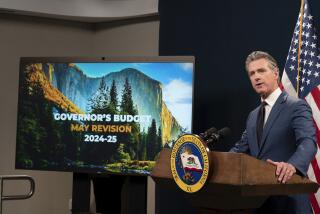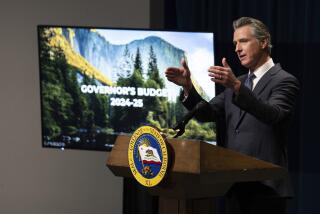As oil prices fall, so do Alaska budget hopes
Reporting from ANCHORAGE — As Allen Newton, 58, filled his ice-caked Ford Expedition for $3.15 a gallon, he happily tried to remember the last time gasoline was so cheap here in Alaska’s biggest city.
“It’s been a long time coming,” Newton said Sunday afternoon, breath steaming outside a downtown gas station.
At the same time a few blocks away, freshly elected Gov. Bill Walker met with his new bipartisan Cabinet. He was talking about oil prices too.
A crash in Alaska North Slope crude prices that echoes a worldwide drop in the price of oil has raised the possibility of multibillion-dollar deficits in a state where 88 cents of every dollar spent by state government comes from oil production.
Alaska crude hit a four-year low of $60.80 a barrel Thursday, a collapse that threatens jobs, public services and some of the ambitious infrastructure projects needed to harness and navigate the state’s vast natural landscape.
State officials are now projecting a $3.5-billion shortfall in funding the state’s original spending plans. Across the U.S., oil-producing states are feeling the pinch. Louisiana is mulling cuts in youth programs and road maintenance to fill a $180-million funding gap. New Mexico recently cut its projected revenue growth in half. North Dakota is counting on a rebound in oil prices, higher taxes and increased production to help balance its budget.
None are facing a situation quite so precarious as Alaska’s, because no other state relies so heavily on oil production.
“This isn’t the hand we thought we would be dealt, quite honestly,” said Walker, an independent who defeated Republican Sean Parnell in November. “Nobody anticipated this.”
After meeting with his still-forming team of budget writers and advisors over the weekend, Walker on Monday introduced a stripped-down state spending plan for construction projects. The budget is half the size of the one proposed by Parnell and removes money, for now, to pay for “mega projects” such as the 1.7-mile Knik Arm bridge that would connect Anchorage to the fast-growing suburbs around Palmer and Wasilla.
“Some things will be stopped. Some things will be shelved,” Walker said of the projects.
If the low prices persist, Alaskans will slowly notice a raft of hidden costs from increased state university tuition to parking fees at trailheads, said Gunnar Knapp, director of the Institute of Social and Economic Research at the University of Alaska in Anchorage. “If the state stops, as it undoubtedly will, spending on capital projects or reduces it, then that’s a lot less work in the construction industry.”
The last new Alaska governor who faced oil prices so low was Republican Frank Murkowski, who had just spent 22 years in the U.S. Senate. Murkowski slashed entitlement programs, including a monthly payment for seniors, saying it was time Alaska tried to live within its means.
Voters replaced him with Sarah Palin in the following election.
Walker takes office supported by an unusual bipartisan coalition. A longtime Republican who teamed with the Democratic nominee in a “unity ticket,” the former Valdez mayor said he would seek to make urgent cuts that would not cripple the state economy long-term.
Alaska has about $13 billion in rainy-day savings accounts that will last four to five years at current oil prices and forecasts, provided the new administration makes “prudent reductions,” said Office of Management and Budget Director Pat Pitney.
Alaskans also enjoy some of the lowest taxes in the country, with no state sales tax or income tax. Nearly every year-round resident receives an annual check paid for with earnings from a $51-billion Permanent Fund created at a time of windfall oil revenue.
Politicians here are loath to suggest that Permanent Fund revenue be tapped to pay for government, and Walker has said he’ll instead focus on cutting state spending, or enacting some broad-based tax.
But spending cuts alone won’t work. The state could refuse to spend a dollar on new construction and still barely make a dent in the projected shortfall.
“The real question becomes, ‘How much are we comfortable drawing down on our savings?’” Walker said.
The short-term spending crisis facing the state this year might be a preview of a bigger problem to come. At peak production, more than 2 million barrels of oil day flowed through the Trans-Alaska Oil Pipeline in 1988 to fuel the state economy. Production has since declined to fewer than 600,000 barrels a day.
A revenue report published last week by the state Tax Division predicts a slight increase in the number of barrels being produced on Alaska’s North Slope, but that improvement pales in comparison to the impact of rock-bottom oil prices across the globe.
Prices have plummeted 40% since July, and it’s anyone’s guess how long the slump will continue, Walker said.
The governor introduced a draft $106.7-million state construction budget on Monday. Any project that does not bring in federal matching funds, or that Alaska is not legally required to build, has been removed.
Stricken from the capital budget are the Knik Arm crossing that would connect Anchorage to mostly undeveloped land across the murky waters of Cook Inlet, plus a mining access road across remote tundra in northwest Alaska and $20 million for a 735-foot dam on the Susitna River.
“We want to take a hard, hard look at which investments are going to make the most difference for Alaska’s future,” Pitney said.
Hopkins is a special correspondent.
The Associated Press contributed to this report.
More to Read
Sign up for Essential California
The most important California stories and recommendations in your inbox every morning.
You may occasionally receive promotional content from the Los Angeles Times.










